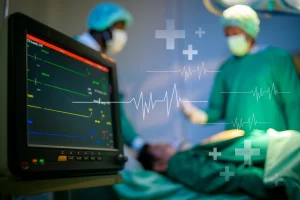
Recent Post
- What Maintenance Is Required for an AED: Everything You Need To Know
November 14, 2025  Could You Recognise the Signs That Someone Needs a Defibrillator?
Could You Recognise the Signs That Someone Needs a Defibrillator?
September 12, 2023
Bystander defibrillation is crucial in saving lives in Australia. Defibrillators are vital in cardiac emergencies and can improve survival rates significantly.
Cardiac arrests are a leading cause of death. Early defibrillation is essential to restore the heart’s normal rhythm and increase the chances of survival. Bystander defibrillation has become increasingly crucial as response time is critical in cardiac events.
Having defibrillators readily available in public locations such as schools, airports, and sports venues can save lives. The Australian resuscitation council recommends early access to defibrillation and cpr for survival from a cardiac arrest. Defibrillator training is readily available, and everyone should learn basic cpr and defibrillation skills to be prepared for emergencies. In this article, we will explore the significance of defibrillators in saving lives and the importance of public access to defibrillators.
Understanding Defibrillators
Defibrillators, also known as aeds (automated external defibrillators), are crucial lifesavers that can be found in public spaces such as shopping malls, sports centres, and airports. These machines can even be found in some workplaces and homes. Understanding the science behind defibrillators, the different types available in Australia, and their cost implications is vital.
The Science Behind Defibrillators And How They Work To Save Lives
Defibrillators are machines that use electrical currents to shock the heart into a regular rhythm, known as defibrillation. They work by analysing a person’s heart rhythm through contact pads that are placed on the person’s chest. If the defibrillator detects an abnormal heartbeat, it will send a shock through the person’s chest, which can sometimes stop the heart and allow it to start beating in a regular rhythm.
The Different Types Of Defibrillators Available
There are two main types of defibrillators available – public access defibrillators and professional-grade defibrillators. Public access defibrillators are the most common type and are typically found in public places. Professional-grade defibrillators are used by medical professionals and require special training to operate.
Both types are effective in saving lives, but public access defibrillators are designed for ease of use by someone with no medical training.
The Cost Implications For Purchasing A Defibrillator
The cost of purchasing a defibrillator can vary depending on the type and features, ranging from a few hundred dollars to thousands of dollars. Although defibrillators can be costly, they are a lifeline in emergency situations and can save lives.
Many public access defibrillators are donated or fundraised by organisations and individuals. Additionally, some workplaces may be eligible for government grants to purchase a defibrillator.
Defibrillators are a life-saving device that can be found in many public places, workplaces and even homes. Understanding the science behind their operation, the different types available, and their cost implications is an essential step in promoting the widespread use of defibrillators, ultimately leading to more lives being saved.
The Importance Of Defibrillators In The Workplace
Defibrillators are becoming increasingly commonplace in Australian workplaces and with good reason. These devices can save lives, especially in a work environment where accidents or emergencies can occur. Here are some key points on the importance of defibrillators in the workplace:
Requirements And Guidelines For Workplaces To Have Access To Defibrillators
- Workplaces have a duty of care to ensure the safety of their employees, which includes access to emergency medical equipment such as defibrillators.
- The australian resuscitation council provides guidelines on defibrillator use, including training requirements for employees and regular maintenance checks for the device.
- Workplaces should consider the size, location, and potential risks of their workplace when determining how many defibrillators are needed and where they should be placed.
The Role Of Employers In Maintaining A Safe And Secure Work Environment For Employees
- Employers have a responsibility to ensure that their employees are adequately trained in first aid and emergency procedures, including defibrillator use.
- By providing access to defibrillators and ensuring that employees know how to use them, employers can increase the chances of survival for someone experiencing sudden cardiac arrest in the workplace.
- In addition to providing access to defibrillators, employers should also have a plan in place for responding to emergencies and providing ongoing support to employees who have experienced a traumatic event.
Case Studies From Workplaces That Have Used Defibrillators To Save Lives
- In 2018, a man suffered a cardiac arrest at a western Australian construction site. Thanks to the quick thinking and training of the site’s first-aid officer, who used a defibrillator to revive him, the man survived and made a full recovery.
- A Victorian school also made headlines in 2018 when a defibrillator saved the life of a student who collapsed during a basketball game. The school had installed two defibrillators just weeks before the incident occurred.
- These examples demonstrate the importance of having access to defibrillators in the workplace and the potential for these devices to save lives.
Defibrillators can make a significant difference in the outcome of a cardiac arrest event, particularly in the workplace. Employers have a duty of care to provide a safe and healthy working environment, which includes access to emergency medical equipment such as defibrillators.
With proper maintenance and training, these devices can be lifesavers for both employees and visitors alike.
Community Access To Defibrillators
The Availability Of Defibrillators In Public Places Across
Sudden cardiac arrest is a major cause of death, with around nine out of ten people dying from it. However, studies show that survival rates can be as high as 70% with immediate defibrillation. It highlights the importance of defibrillators in public areas.
Below are some key points about the availability of defibrillators in public places:
- The government has mandated defibrillators to be placed in some public spaces, like airports and train stations.
- There are also private companies that have installed defibrillators in their office buildings and factories to ensure the safety of their employees.
- In Victoria, there is a registered database of where public access defibrillators are located.
The Importance Of Public Awareness About The Locations Of Defibrillators
Having defibrillators in public places is one step towards saving more lives. However, it is equally important for the public to be aware of their locations. In a situation of sudden cardiac arrest, every second counts, and locating a defibrillator can be a matter of life and death.
Take a look at some important points to bear in mind:
- Creating public awareness campaigns to spread the message on defibrillator locations in high-traffic areas and public places can be of great help.
- The use of visual aids, such as posters, infographics and maps, can further assist in highlighting the defibrillator locations.
The Role Of Community Organisations In Sponsoring Aeds To Be Placed In Public Spaces
Community organisations play a vital role in sponsoring automatic external defibrillators (aeds) to be placed in public spaces. They can be instrumental in ensuring that these life-saving devices become more readily available in public places, particularly in those areas where the public has limited access to healthcare.
Here are some of the key points about community organisations sponsoring aeds:
- They can partner with local councils and the government to sponsor aeds to be placed in high-risk public spaces, like sports grounds and parks.
- Organisations can also sponsor defibrillators to be placed in their local communities or purchase portable aeds for their staff and volunteers to use at public events.
Future Developments And Their Implications
Technological Advancements In Defibrillators And Their Impact On The Healthcare Industry
The healthcare industry has been growing rapidly with advancements in technology. The introduction of sophisticated machines, such as defibrillators, has had a significant impact on how medical emergencies are handled. Here are some key points to consider:
- Modern defibrillators are smaller and portable, allowing them to be available in more locations. This significantly increases the chances of quick treatment and in turn, improves survival rates.
- Some defibrillators are now equipped with artificial intelligence (ai), allowing medical professionals to analyse patient data in real time, creating a more accurate diagnosis and personalised treatment plan.
- The use of mobile applications that can connect with defibrillators has surged in recent years. These apps provide real-time emergency response maps, allowing medical professionals to cater to emergencies promptly and efficiently.
Investment Opportunities For Businesses In The Healthcare Sector
The healthcare sector is a lucrative industry that has been booming in recent years. The country has an ageing population with growing healthcare needs, resulting in a significant demand for healthcare services and products. Here are some investment opportunities for businesses:
- There is a large demand for local and affordable medical equipment, such as defibrillators, which creates an opportunity for production and supply.
- The healthcare data analytics sector is also an area of high potential and is expected to grow in the coming years. Investing in this sector can lead to massive returns in the long term.
- The use of technology in healthcare is on the rise, creating opportunities for innovative solutions such as mobile applications, telemedicine, and ai-powered healthcare devices.
The Role Of The Government In Promoting The Use Of Defibrillators In Emergencies
The australian government has a critical role to play in promoting the use of defibrillators in emergencies. Here are some ways the government can support the use of defibrillators:
- The government can provide funding for the installation of defibrillators in public amenities such as parks, beaches, and shopping centres.
- The government can also work with businesses to provide tax incentives for organisations that install defibrillators on their premises.
- The government can also offer free CPR and defibrillator training to the general public to increase awareness and knowledge of how to respond to emergencies effectively.
The advancements in technology, investment opportunities, and support from the government show how defibrillators are essential in saving lives. It is crucial to have these life-saving devices readily available in public places, businesses, and homes. We hope that the increasing importance of defibrillators would encourage more businesses and individuals to invest in these devices and promote their use in emergencies.
Priority First Aid: Your Partner in Lifesaving Defibrillator Supply in Australia
Ensuring Heart Health
At Priority First Aid, we understand the importance of immediate cardiac intervention. We provide top-quality defibrillators, essential in saving lives in Australia.
Facilitating Emergency Preparedness
We aid businesses, schools, and individuals to be prepared for cardiac emergencies. Our wide range of Automated External Defibrillators (AEDs) ensures you’re always equipped.
Training and Support
Apart from supplying lifesaving equipment, we offer comprehensive AED training to help you act confidently during cardiac emergencies. We ensure that help is always within reach.
Nationwide Reach
With our reliable distribution network across Australia, we’re committed to providing defibrillators wherever they’re needed, because every second counts.
Committed to Saving Lives
At Priority First Aid, we’re more than a supplier – we’re your partners in prioritising heart health and saving lives in Australia.
Conclusion
The importance of defibrillators in saving lives cannot be overemphasised. Defibrillators provide a lifeline in emergency situations where every second counts. With cardiac arrest being one of the leading causes of death, it is crucial that defibrillators are readily available in public places and workplaces.
This is backed up by the fact that prompt defibrillation can increase survival rates by up to 70%. There have been remarkable improvements in the availability and accessibility of defibrillators, with many organisations taking steps to install them in their workplaces and public areas.
However, raising awareness about the importance of defibrillators remains crucial. More Australians need to understand the benefits of defibrillators and how to use them effectively. Defibrillators play a vital role in saving lives, and their importance cannot be overstated. With the right education and accessibility, defibrillators can make a significant difference in reducing the number of cardiac-related deaths.




